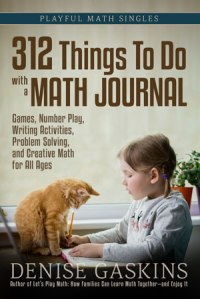Writing to Learn Math: Games are the ultimate re-playable activity prompts.
Do you want your children to develop the ability to reason creatively and figure out things on their own?
Help kids practice slowing down and taking the time to fully comprehend a math topic or problem-solving situation with these classic tools of learning: Notice. Wonder. Create.
Notice: Look carefully at the details of the numbers, shapes, or patterns you see. What are their attributes? How do they relate to each other? Also notice the details of your own mathematical thinking. How do you respond to a tough problem? Which responses are most helpful? Where did you get confused, or what makes you feel discouraged?
Wonder: Ask the journalist’s questions: who, what, where, when, why, and how? Who might need to know about this topic? Where might we see it in the real world? When would things happen this way? What other way might they happen? Why? What if we changed the situation? How might we change it? What would happen then? How might we figure it out?
Create: Create a description, summary, or explanation of what you learned. Make your own related math puzzle, problem, art, poetry, story, game, etc. Or create something totally unrelated, whatever idea may have sparked in your mind.
Math journaling may seem to focus on this third tool, creation. But even with artistic design prompts, we need the first two tools because they lay a solid groundwork to support the child’s imagination.
How To Use a Math Game Prompt
Games are the ultimate re-playable activity prompts. As children repeat a game, they try variations on their previous moves to gain extra advantage. This sort of experiment mirrors the approach a mathematician may take when faced with a problem. What if we try this, or that? How do things change, and what stays the same?
After your child masters the ordinary version of a game, try a misère variation. In a misère game, the move that otherwise would win now makes you the loser. Students must reconsider their strategy and think more deeply about the game.
Encourage children to modify the game rules. What if they changed the number of cards to draw, or how many dice to throw? If the game uses dice, can they figure out a way to play it with cards or dominoes? Or transfer it to a gameboard? Or is there a way to use money in the game? Or can they change it into a whole-body action game? Perhaps using sidewalk chalk?
Older students may want to analyze a game. Does one player have the advantage, or do both players have an equal chance of winning? What’s the best move? Can they find a strategy to increase their odds? How are fairness and randomness linked?
Journaling Prompt 106: Connect 4
(two players)
Draw a 10 × 10 grid of squares or use graph paper. Each player chooses a symbol: X, O, your initial, a small star, etc.
Take turns “dropping” your symbol into a column by marking the lowest open square. Whoever gets four of their own symbols in a row (any direction) without gaps wins the game.
* * *
 This is an excerpt from 312 Things To Do with a Math Journal. Discover more of my books, printable activities, and cool mathy merch at Denise Gaskins’ Playful Math Store.
This is an excerpt from 312 Things To Do with a Math Journal. Discover more of my books, printable activities, and cool mathy merch at Denise Gaskins’ Playful Math Store.
Special Offer: Would you like to access a growing archive of Thinking Thursday prompts and other activity ideas as convenient printable pdf downloads, ready to print and play with your kids? Join me on Patreon for mathy inspiration, tips, printable activities, and more.
“Thinking Thursday: Connect 4” copyright © 2024 by Denise Gaskins. Image at the top of the post copyright © 4masik / Depositphotos.
